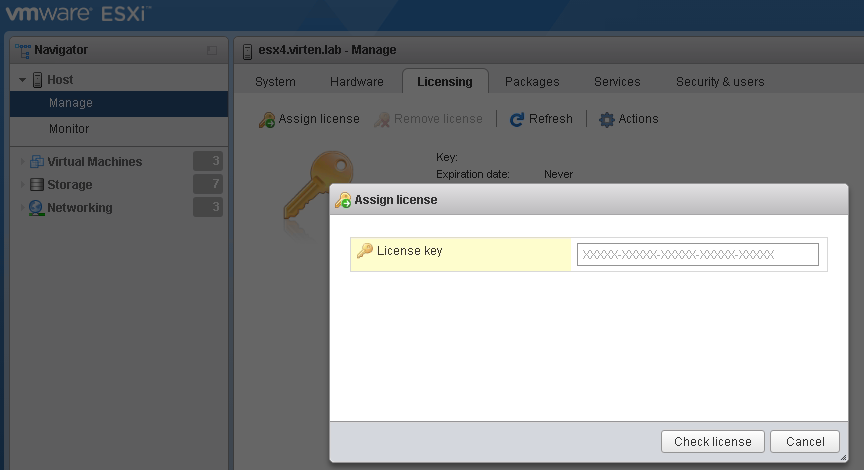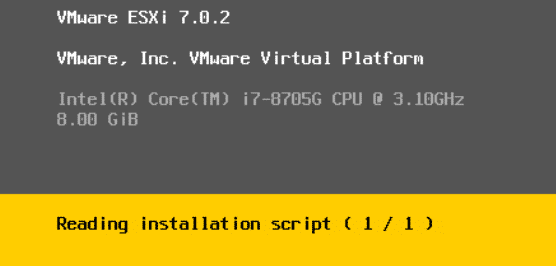
- Vmware esxi 6.7 booting to pxe how to#
- Vmware esxi 6.7 booting to pxe update#
- Vmware esxi 6.7 booting to pxe manual#
- Vmware esxi 6.7 booting to pxe Patch#
- Vmware esxi 6.7 booting to pxe upgrade#
You have to regenerate a new file following these steps: Create a new VM using the same numbers and options (EFI mode, CPU, memory, etc) and use the existing VMDK(s). You need to start the service via ESXi Web Console. Note that TSM-SSH service may stop after the reboot, making the ssh connection impossible. Reboot the host with this command: reboot. Refer to Dell EMC White paper on vSphere Quick boot support stance in detail. The issue is related to the VMX structure which is corrupted. You can observe ESXi quick boot right on the server or using the console in server’s IDRAC.

Vmware esxi 6.7 booting to pxe update#
NOTE: Refer to VMware KB 52477 , Installation Instructions and Important Information Guide and vSphere Update Manager Installation and Administration Guide to ensure your host meets the minimum requirements to support Quick Boot. $ /usr/lib/vmware/loadesx/bin/loadESXCheckCompat.py Dell EMC recommends end users to run this script manually to make sure that the configuration is compatible for quickboot. The following script verifies that the hardware and softwareconfiguration of a given host supports Quick Boot. Please refer to vSphere Update Manage Installation and Administration Guide for instructions on configuration/ use this feature.ĭell EMC and VMware have worked together to enable Quick Boot on the following platforms.
Vmware esxi 6.7 booting to pxe Patch#
For example, applying an ESXi security patch or upgrading the ESXi hypervisor will most likely not require you to have the host/hardware rebooted. This feature helps to speed up server management workflows which do not require a hardware reboot. When you initiate a Quick Boot, ESXi restarts in a way similar to normal reboot operation but the hardware does not go through the normal process of reboot operations such as POST, firmware load, re-initialization of hardware resources, reload ACPI/SMBIOS tables etc. Unlike a regular host reboot operation (warm or cold), Quick Boot does not involve going through the actual hardware reboot process.
Vmware esxi 6.7 booting to pxe how to#
In addition to that, advice is offered on how to control, on a per-host basis. Also note that UEFI even supports IPv6 if you’re into that kind of thing.
Vmware esxi 6.7 booting to pxe manual#
Speaking of reducing manual tasks – this small script that can automatically prepare the contents of an ISO image for PXE use may also be of interest.VMware Quick Boot is a new type of "soft" reboot mechanism introduced in vSphere 6.7. This new technical paper from VMware is a very thorough guide on PXE installation of ESXi 6, including differences between the two major hardware architectures: legacy BIOS and UEFI. So take a look and consider how your environment may benefit by reducing manual tasks required for ESXi host deployment. Details, such as the following boot sequence diagram, contribute to a better understanding in the event troubleshooting is needed.

With vCenter 6.7, the concept of an external PSC is deprecated, and Enhanced Linked Mode between vCenters with embedded PSCs is now fully supported.

This is no longer the case in vSphere 6.7. In addition to that, advice is offered on how to control, on a per-host basis, which configuration files are booted, which can enable a gradual transition. An external PSC was a requirement in the past if you chose to configure Enhanced Linked Mode for your vCenters. Also note that UEFI even supports IPv6 – if you’re into that kind of thing. This new technical paper from VMware is a very thorough guide on PXE installation of ESXi 6, including differences between the two major hardware architectures: legacy BIOS and UEFI. Getting familiar with the required infrastructure, such as DHCP, TFTP, and properly configured DNS today can pave the way for future automation with Auto Deploy technology. For environments not quite ready to dive into this world of highly automated, stateless deployments, then network installs via PXE – either interactive or scripted – are a good starting point.
Vmware esxi 6.7 booting to pxe upgrade#
Today, there are a number of large-scale VMware deployments leveraging Auto Deploy to centrally install, patch, and upgrade ESXi hosts that do not utilize local disks. If you have not yet made the move to PXE deployments, then a new guide from VMware may be the catalyst needed to get your environment moving towards greater operational maturity: It’s 2016, are you still installing VMware ESXi by mounting ISO images in a browser-based console? That’s probably fine for one-off efforts, and it sure beats making a trip to the datacenter with physical CDs, but network deployments are the way of the future.


 0 kommentar(er)
0 kommentar(er)
